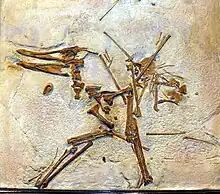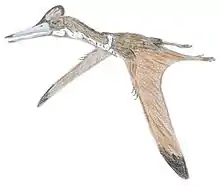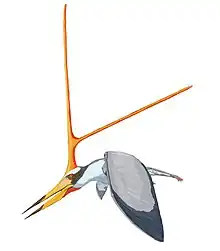Gallodactylidae
Gallodactylidae is a group of pterosaurs within the suborder Pterodactyloidea. Gallodactylids differed from other related pterosaurs in several distinct features, including fewer than 50 teeth present only in the jaw tips, and rounded crests present on the rear portion of the skull and jaws but not near the ends of their snouts. At least some species possessed jaw flanges, possibly used to bissect hard-shelled prey.[2][3]
| Gallodactylidae Temporal range: Late Jurassic, | |
|---|---|
 | |
| Juvenile specimen of Cycnorhamphus suevicus | |
| Scientific classification | |
| Domain: | Eukaryota |
| Kingdom: | Animalia |
| Phylum: | Chordata |
| Order: | †Pterosauria |
| Suborder: | †Pterodactyloidea |
| Clade: | †Ctenochasmatoidea |
| Family: | †Gallodactylidae Fabre, 1974 |
| Type species | |
| †Gallodactylus canjuersensis Fabre, 1974 | |
| Subgroups | |
History
Gallodactylidae was named to contain Gallodactylus (now usually considered a synonym of Cycnorhamphus) and its closest relatives. Many subsequent studies, however, showed that Gallodactylus did not form a clade with any non-synonymous pterosaurs that were not themselves part of a different family, and so the name was often ignored. The name returned to common use with the discovery of Gladocephaloideus, a Chinese pterosaur species that shared many similarities with Cycnorhamphus. Among other features, the Gallodactylidae was distinguished by having teeth only in the front tip of the jaws.[4]
Classification
In 2006, Lü Junchang and colleagues named the clade Boreopteridae for the clade containing the common ancestor of Boreopterus and Feilongus and all its descendants, which the authors reclassified as close relatives of the ornithocheirids, though Feilongus had originally been considered a gallodactylid.[5][6] Originally considered close relatives of the ornithocheirids, many of these supposed boreopterids have since been considered members of other groups of the pterodactyloid lineage. Boreopterus and Feilongus were found by Andres and colleagues in 2013 to be closely related to Cycnorhamphus, making them members of the Gallodactylidae as had been originally thought when Feilongus was discovered.[7] However, a revised version of Andres' analysis, which was updated to include the other supposed boreopterids among other changes, found that Boreopterus itself, and therefore the name Boreopteridae, was indeed a member of the ornithocheiroid clade. This analysis confirmed that Feilongus was in fact a ctenochasmatoid, but one closely related to Gnathosaurus rather than Gallodactylus. This study effectively reduced the membership of Gallodactylidae back to just Gallodactylus and Cycnorhamphus.[7]
Cladogram following the latest version of Andres' data set, published by Longrich, Martill, and Andres in 2018, highlighting the positions of several possible gallodactylids:[8]
| Ctenochasmatoidea |
| ||||||||||||||||||||||||||||||||||||||||||||||||||||||||||||||||||||||||||||||
In a 2014 study, Steven Vidovic and David Martill concluded that Pterodactylus scolopaciceps, usually considered a synonym of Diopecephalus and/or Pterodactylus, was not closely related to other Pterodactylus specimens. They placed it in the new genus Aerodactylus, which they found to be most closely related to Cynorhamphus. They initially named this clade Aurorazhdarchidae, and defined it as the most recent common ancestor of Aerodactylus scolopaciceps and Aurorazhdarcho micronyx, and all its descendants.[9] In follow-up studies, they found that this group is actually nested within the traditional grouping of Gallodactylidae. They proposed new, more restrictive definitions for both Gallodactylidae and Aurorazhdarchidae, and created another new clade, Aurorazhdarchia, with a definition equivalent to the old Aurorazhdarchidae.[10]
Cladogram following Vidovic and Martill, 2017, highlighting the positions of several possible gallodactylids:[10]
| Ctenochasmatoidea |
| ||||||||||||||||||||||||||||||||||||||||||
References
- Hone, David W.E.; Lauer, René; Lauer, Bruce; Spindler, Frederik (2023-07-14). "Petrodactyle wellnhoferi gen. et sp. nov.: A new and large ctenochasmatid pterosaur from the Late Jurassic of Germany". Palaeontologia Electronica: 26.2.a25. doi:10.26879/1251.
- Witton, Mark P. (2013), Pterosaurs: Natural History, Evolution, Anatomy
- Bennett, S. C. (2013). "The morphology and taxonomy of the pterosaur Cycnorhamphus". Neues Jahrbuch für Geologie und Paläontologie - Abhandlungen. 267: 23–41. doi:10.1127/0077-7749/2012/0295.
- Lü Junchang; Ji Qiang; Wei Xuefang; Liu Yongqing (2012). "A new ctenochasmatoid pterosaur from the Early Cretaceous Yixian Formation of western Liaoning, China". Cretaceous Research. 34: 26–30. doi:10.1016/j.cretres.2011.09.010.
- Mark Witton, 2011
- Myers, Timothy S. (2010). "A new ornithocheirid pterosaur from the Upper Cretaceous (Cenomanian–Turonian) Eagle Ford Group of Texas" (PDF). Journal of Vertebrate Paleontology. 30 (1): 280–287. doi:10.1080/02724630903413099. S2CID 130367018.
- Andres, B.; Clark, J.; Xu, X. (2014). "The Earliest Pterodactyloid and the Origin of the Group". Current Biology. 24 (9): 1011–6. doi:10.1016/j.cub.2014.03.030. PMID 24768054.
- Longrich, N.R.; Martill, D.M.; Andres, B. (2018). "Late Maastrichtian pterosaurs from North Africa and mass extinction of Pterosauria at the Cretaceous-Paleogene boundary". PLOS Biology. 16 (3): e2001663. doi:10.1371/journal.pbio.2001663. PMC 5849296. PMID 29534059.
- Vidovic, S. U.; Martill, D. M. (2014). "Pterodactylus scolopaciceps Meyer, 1860 (Pterosauria, Pterodactyloidea) from the Upper Jurassic of Bavaria, Germany: The Problem of Cryptic Pterosaur Taxa in Early Ontogeny". PLOS ONE. 9 (10): e110646. doi:10.1371/journal.pone.0110646. PMC 4206445. PMID 25337830.
- Vidovic, S.U.; Martill, D.M. (2017). "The taxonomy and phylogeny of Diopecephalus kochi (Wagner, 1837) and "Germanodactylus rhamphastinus" (Wagner, 1851)". Geological Society, London, Special Publications. 455: 125–147. doi:10.1144/SP455.12. S2CID 219204038.












